Functional Analysis and Allocation Report - Systems Engineering
VerifiedAdded on 2022/10/06
|15
|3278
|203
Report
AI Summary
This report provides a comprehensive review of the Functional Analysis and Allocation (FA&A) process, a crucial element in systems engineering design. It begins with an introduction to FA&A, explaining its purpose and importance in translating system requirements into specific functional and performance criteria. The report then details the FA&A process, including its inputs, outputs, and how it is staged within the system life-cycle. It further explores various approaches and methods for performing functional analysis, such as functional partitioning and the requirements loop, which are essential for defining the functions of a system. The report also examines different approaches and methods for functional allocation, discussing how functions are assigned to components, considering factors like human factors and technology. The report concludes by summarizing the key findings and emphasizing the importance of FA&A in successful system design. The report incorporates multiple references and adheres to the specified assessment criteria, including research skills, layout, and presentation.
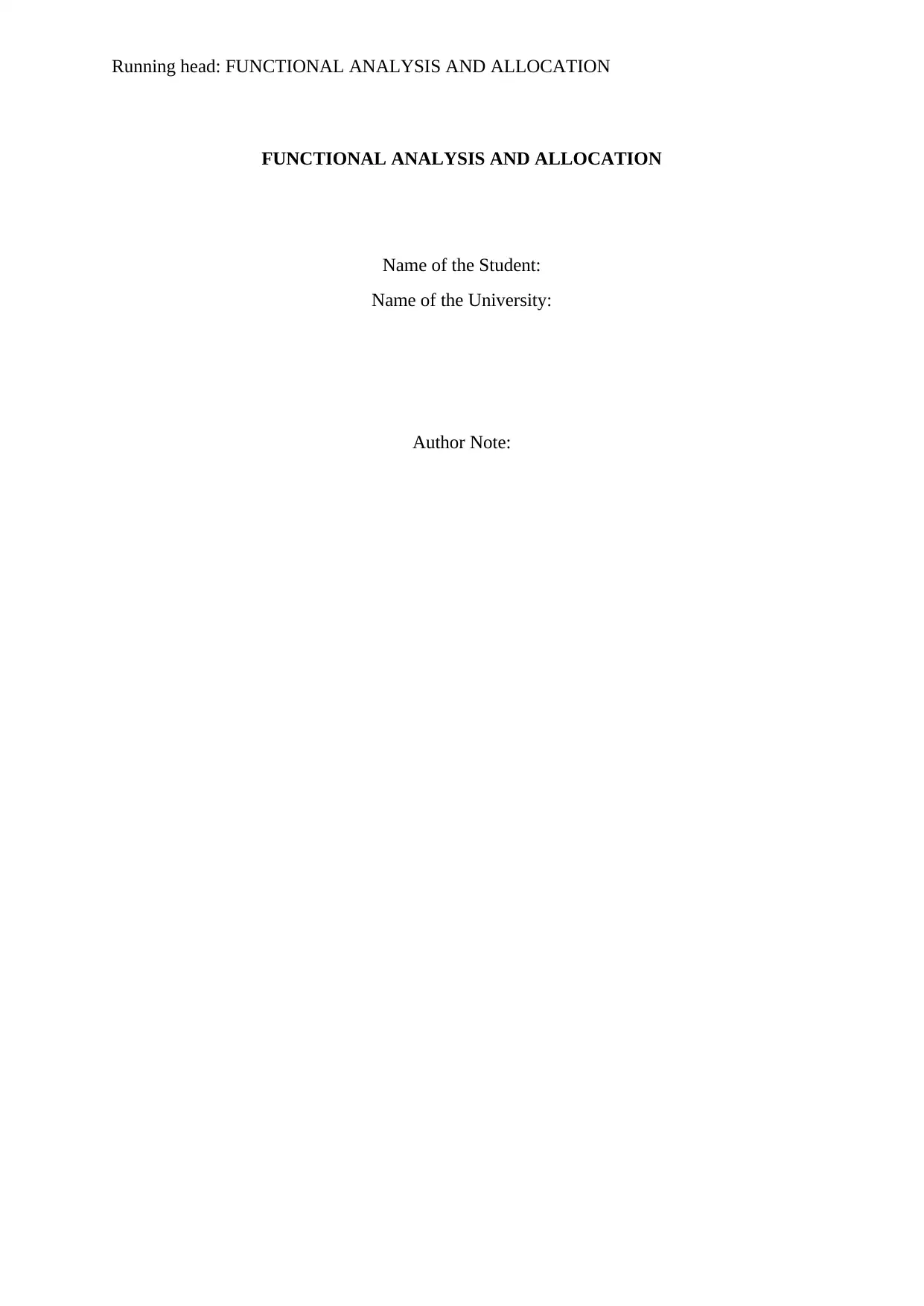
Running head: FUNCTIONAL ANALYSIS AND ALLOCATION
FUNCTIONAL ANALYSIS AND ALLOCATION
Name of the Student:
Name of the University:
Author Note:
FUNCTIONAL ANALYSIS AND ALLOCATION
Name of the Student:
Name of the University:
Author Note:
Paraphrase This Document
Need a fresh take? Get an instant paraphrase of this document with our AI Paraphraser
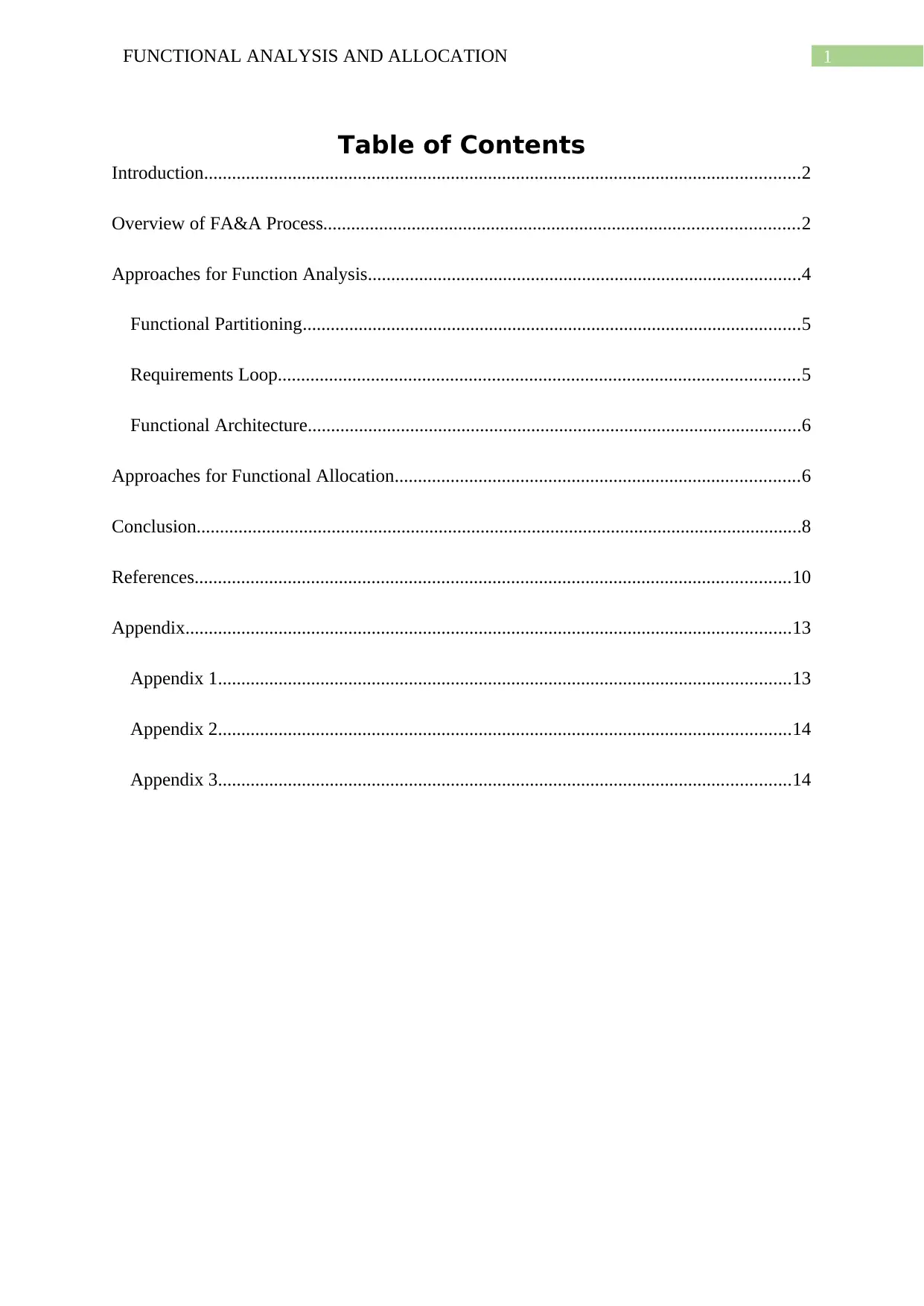
1FUNCTIONAL ANALYSIS AND ALLOCATION
Table of Contents
Introduction................................................................................................................................2
Overview of FA&A Process......................................................................................................2
Approaches for Function Analysis.............................................................................................4
Functional Partitioning...........................................................................................................5
Requirements Loop................................................................................................................5
Functional Architecture..........................................................................................................6
Approaches for Functional Allocation.......................................................................................6
Conclusion..................................................................................................................................8
References................................................................................................................................10
Appendix..................................................................................................................................13
Appendix 1...........................................................................................................................13
Appendix 2...........................................................................................................................14
Appendix 3...........................................................................................................................14
Table of Contents
Introduction................................................................................................................................2
Overview of FA&A Process......................................................................................................2
Approaches for Function Analysis.............................................................................................4
Functional Partitioning...........................................................................................................5
Requirements Loop................................................................................................................5
Functional Architecture..........................................................................................................6
Approaches for Functional Allocation.......................................................................................6
Conclusion..................................................................................................................................8
References................................................................................................................................10
Appendix..................................................................................................................................13
Appendix 1...........................................................................................................................13
Appendix 2...........................................................................................................................14
Appendix 3...........................................................................................................................14
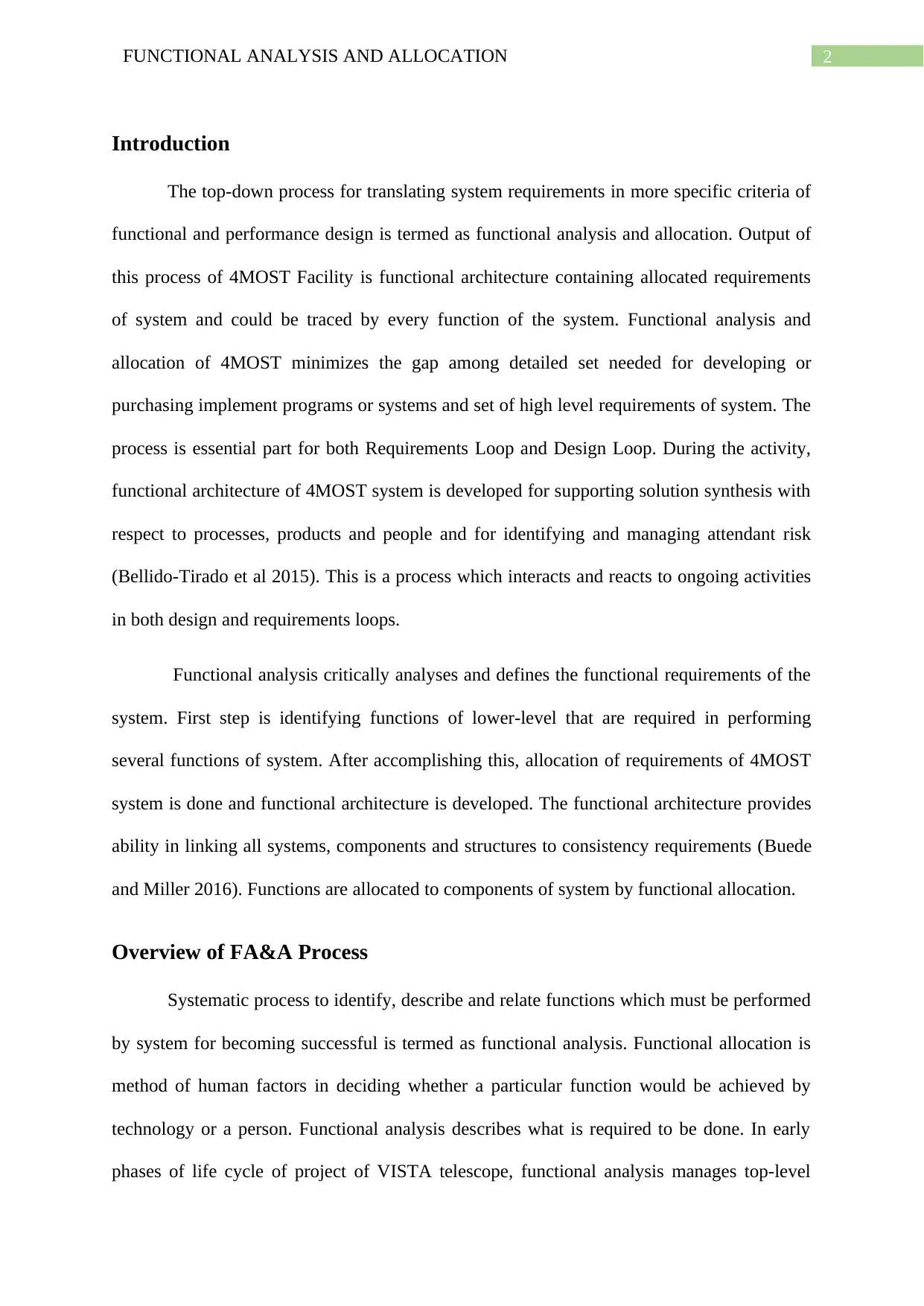
2FUNCTIONAL ANALYSIS AND ALLOCATION
Introduction
The top-down process for translating system requirements in more specific criteria of
functional and performance design is termed as functional analysis and allocation. Output of
this process of 4MOST Facility is functional architecture containing allocated requirements
of system and could be traced by every function of the system. Functional analysis and
allocation of 4MOST minimizes the gap among detailed set needed for developing or
purchasing implement programs or systems and set of high level requirements of system. The
process is essential part for both Requirements Loop and Design Loop. During the activity,
functional architecture of 4MOST system is developed for supporting solution synthesis with
respect to processes, products and people and for identifying and managing attendant risk
(Bellido-Tirado et al 2015). This is a process which interacts and reacts to ongoing activities
in both design and requirements loops.
Functional analysis critically analyses and defines the functional requirements of the
system. First step is identifying functions of lower-level that are required in performing
several functions of system. After accomplishing this, allocation of requirements of 4MOST
system is done and functional architecture is developed. The functional architecture provides
ability in linking all systems, components and structures to consistency requirements (Buede
and Miller 2016). Functions are allocated to components of system by functional allocation.
Overview of FA&A Process
Systematic process to identify, describe and relate functions which must be performed
by system for becoming successful is termed as functional analysis. Functional allocation is
method of human factors in deciding whether a particular function would be achieved by
technology or a person. Functional analysis describes what is required to be done. In early
phases of life cycle of project of VISTA telescope, functional analysis manages top-level
Introduction
The top-down process for translating system requirements in more specific criteria of
functional and performance design is termed as functional analysis and allocation. Output of
this process of 4MOST Facility is functional architecture containing allocated requirements
of system and could be traced by every function of the system. Functional analysis and
allocation of 4MOST minimizes the gap among detailed set needed for developing or
purchasing implement programs or systems and set of high level requirements of system. The
process is essential part for both Requirements Loop and Design Loop. During the activity,
functional architecture of 4MOST system is developed for supporting solution synthesis with
respect to processes, products and people and for identifying and managing attendant risk
(Bellido-Tirado et al 2015). This is a process which interacts and reacts to ongoing activities
in both design and requirements loops.
Functional analysis critically analyses and defines the functional requirements of the
system. First step is identifying functions of lower-level that are required in performing
several functions of system. After accomplishing this, allocation of requirements of 4MOST
system is done and functional architecture is developed. The functional architecture provides
ability in linking all systems, components and structures to consistency requirements (Buede
and Miller 2016). Functions are allocated to components of system by functional allocation.
Overview of FA&A Process
Systematic process to identify, describe and relate functions which must be performed
by system for becoming successful is termed as functional analysis. Functional allocation is
method of human factors in deciding whether a particular function would be achieved by
technology or a person. Functional analysis describes what is required to be done. In early
phases of life cycle of project of VISTA telescope, functional analysis manages top-level
⊘ This is a preview!⊘
Do you want full access?
Subscribe today to unlock all pages.

Trusted by 1+ million students worldwide
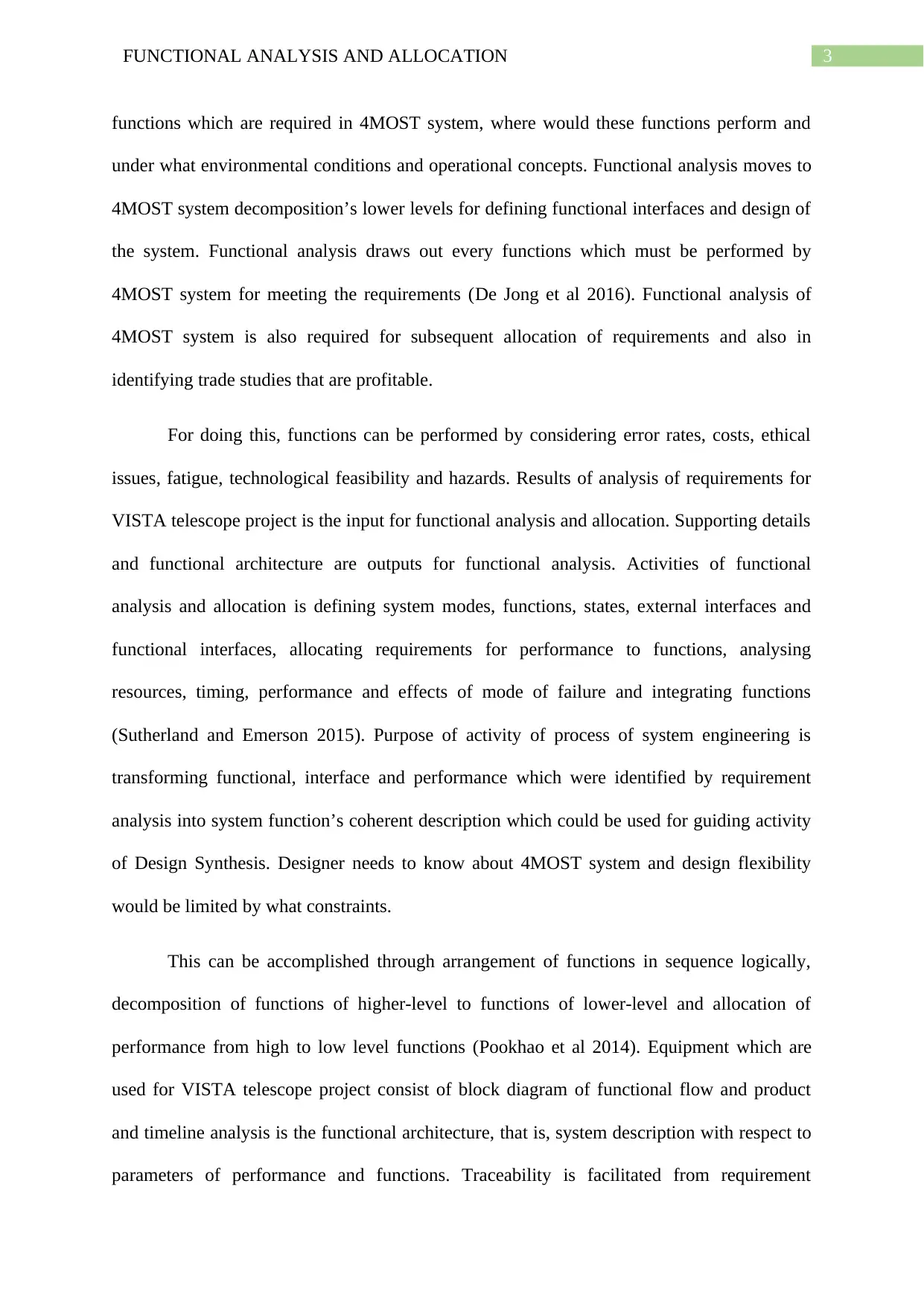
3FUNCTIONAL ANALYSIS AND ALLOCATION
functions which are required in 4MOST system, where would these functions perform and
under what environmental conditions and operational concepts. Functional analysis moves to
4MOST system decomposition’s lower levels for defining functional interfaces and design of
the system. Functional analysis draws out every functions which must be performed by
4MOST system for meeting the requirements (De Jong et al 2016). Functional analysis of
4MOST system is also required for subsequent allocation of requirements and also in
identifying trade studies that are profitable.
For doing this, functions can be performed by considering error rates, costs, ethical
issues, fatigue, technological feasibility and hazards. Results of analysis of requirements for
VISTA telescope project is the input for functional analysis and allocation. Supporting details
and functional architecture are outputs for functional analysis. Activities of functional
analysis and allocation is defining system modes, functions, states, external interfaces and
functional interfaces, allocating requirements for performance to functions, analysing
resources, timing, performance and effects of mode of failure and integrating functions
(Sutherland and Emerson 2015). Purpose of activity of process of system engineering is
transforming functional, interface and performance which were identified by requirement
analysis into system function’s coherent description which could be used for guiding activity
of Design Synthesis. Designer needs to know about 4MOST system and design flexibility
would be limited by what constraints.
This can be accomplished through arrangement of functions in sequence logically,
decomposition of functions of higher-level to functions of lower-level and allocation of
performance from high to low level functions (Pookhao et al 2014). Equipment which are
used for VISTA telescope project consist of block diagram of functional flow and product
and timeline analysis is the functional architecture, that is, system description with respect to
parameters of performance and functions. Traceability is facilitated from requirement
functions which are required in 4MOST system, where would these functions perform and
under what environmental conditions and operational concepts. Functional analysis moves to
4MOST system decomposition’s lower levels for defining functional interfaces and design of
the system. Functional analysis draws out every functions which must be performed by
4MOST system for meeting the requirements (De Jong et al 2016). Functional analysis of
4MOST system is also required for subsequent allocation of requirements and also in
identifying trade studies that are profitable.
For doing this, functions can be performed by considering error rates, costs, ethical
issues, fatigue, technological feasibility and hazards. Results of analysis of requirements for
VISTA telescope project is the input for functional analysis and allocation. Supporting details
and functional architecture are outputs for functional analysis. Activities of functional
analysis and allocation is defining system modes, functions, states, external interfaces and
functional interfaces, allocating requirements for performance to functions, analysing
resources, timing, performance and effects of mode of failure and integrating functions
(Sutherland and Emerson 2015). Purpose of activity of process of system engineering is
transforming functional, interface and performance which were identified by requirement
analysis into system function’s coherent description which could be used for guiding activity
of Design Synthesis. Designer needs to know about 4MOST system and design flexibility
would be limited by what constraints.
This can be accomplished through arrangement of functions in sequence logically,
decomposition of functions of higher-level to functions of lower-level and allocation of
performance from high to low level functions (Pookhao et al 2014). Equipment which are
used for VISTA telescope project consist of block diagram of functional flow and product
and timeline analysis is the functional architecture, that is, system description with respect to
parameters of performance and functions. Traceability is facilitated from requirement
Paraphrase This Document
Need a fresh take? Get an instant paraphrase of this document with our AI Paraphraser
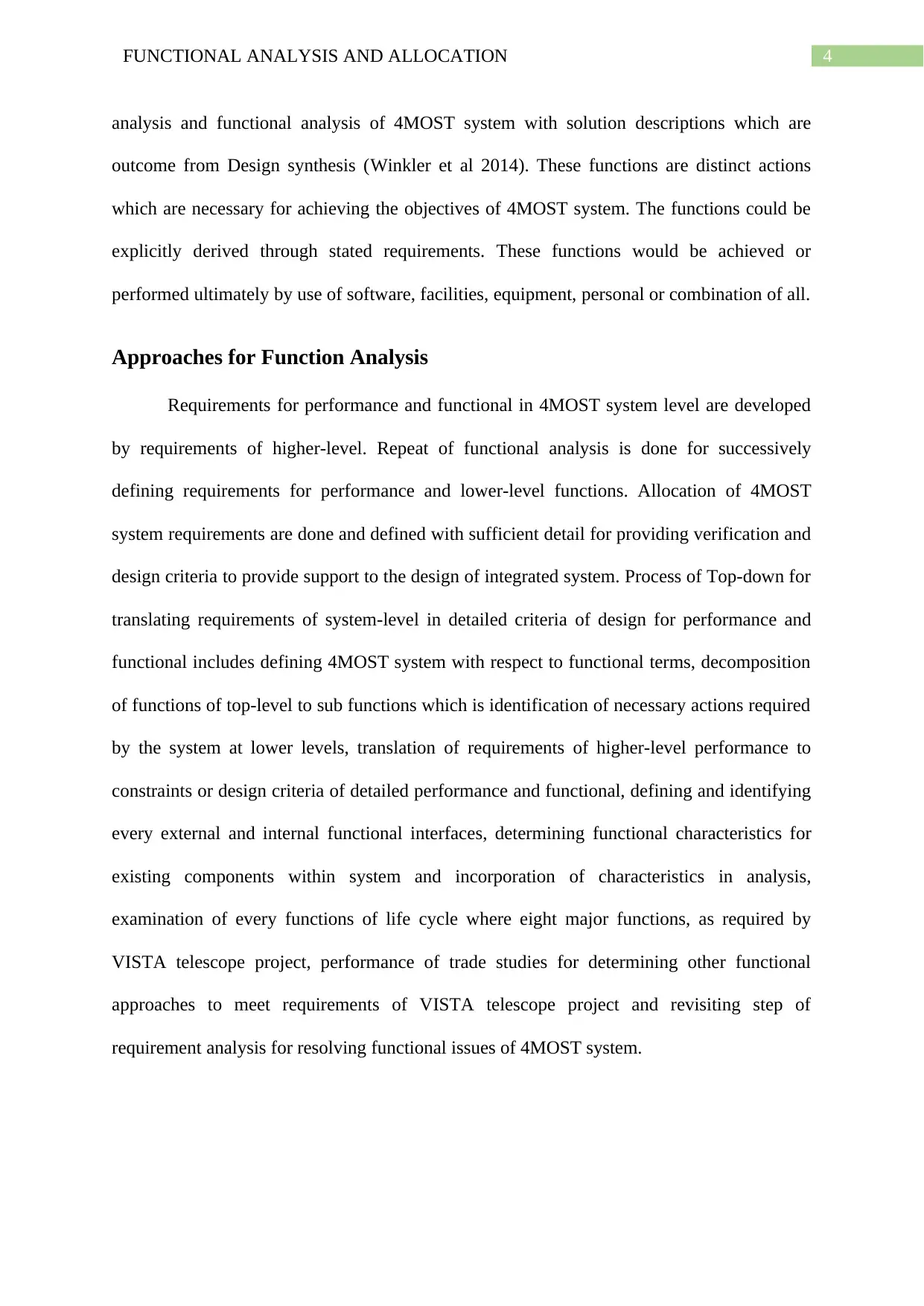
4FUNCTIONAL ANALYSIS AND ALLOCATION
analysis and functional analysis of 4MOST system with solution descriptions which are
outcome from Design synthesis (Winkler et al 2014). These functions are distinct actions
which are necessary for achieving the objectives of 4MOST system. The functions could be
explicitly derived through stated requirements. These functions would be achieved or
performed ultimately by use of software, facilities, equipment, personal or combination of all.
Approaches for Function Analysis
Requirements for performance and functional in 4MOST system level are developed
by requirements of higher-level. Repeat of functional analysis is done for successively
defining requirements for performance and lower-level functions. Allocation of 4MOST
system requirements are done and defined with sufficient detail for providing verification and
design criteria to provide support to the design of integrated system. Process of Top-down for
translating requirements of system-level in detailed criteria of design for performance and
functional includes defining 4MOST system with respect to functional terms, decomposition
of functions of top-level to sub functions which is identification of necessary actions required
by the system at lower levels, translation of requirements of higher-level performance to
constraints or design criteria of detailed performance and functional, defining and identifying
every external and internal functional interfaces, determining functional characteristics for
existing components within system and incorporation of characteristics in analysis,
examination of every functions of life cycle where eight major functions, as required by
VISTA telescope project, performance of trade studies for determining other functional
approaches to meet requirements of VISTA telescope project and revisiting step of
requirement analysis for resolving functional issues of 4MOST system.
analysis and functional analysis of 4MOST system with solution descriptions which are
outcome from Design synthesis (Winkler et al 2014). These functions are distinct actions
which are necessary for achieving the objectives of 4MOST system. The functions could be
explicitly derived through stated requirements. These functions would be achieved or
performed ultimately by use of software, facilities, equipment, personal or combination of all.
Approaches for Function Analysis
Requirements for performance and functional in 4MOST system level are developed
by requirements of higher-level. Repeat of functional analysis is done for successively
defining requirements for performance and lower-level functions. Allocation of 4MOST
system requirements are done and defined with sufficient detail for providing verification and
design criteria to provide support to the design of integrated system. Process of Top-down for
translating requirements of system-level in detailed criteria of design for performance and
functional includes defining 4MOST system with respect to functional terms, decomposition
of functions of top-level to sub functions which is identification of necessary actions required
by the system at lower levels, translation of requirements of higher-level performance to
constraints or design criteria of detailed performance and functional, defining and identifying
every external and internal functional interfaces, determining functional characteristics for
existing components within system and incorporation of characteristics in analysis,
examination of every functions of life cycle where eight major functions, as required by
VISTA telescope project, performance of trade studies for determining other functional
approaches to meet requirements of VISTA telescope project and revisiting step of
requirement analysis for resolving functional issues of 4MOST system.
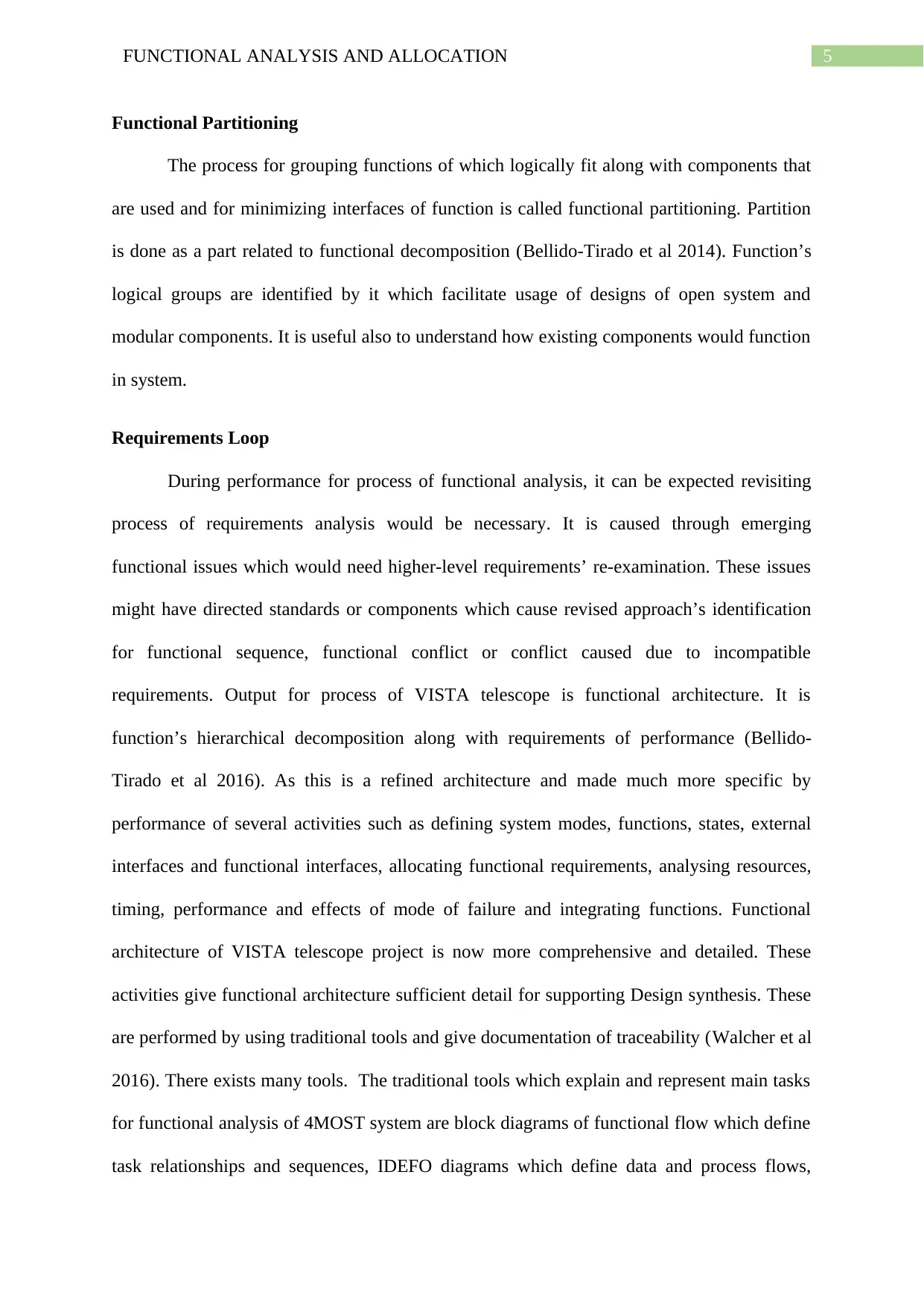
5FUNCTIONAL ANALYSIS AND ALLOCATION
Functional Partitioning
The process for grouping functions of which logically fit along with components that
are used and for minimizing interfaces of function is called functional partitioning. Partition
is done as a part related to functional decomposition (Bellido-Tirado et al 2014). Function’s
logical groups are identified by it which facilitate usage of designs of open system and
modular components. It is useful also to understand how existing components would function
in system.
Requirements Loop
During performance for process of functional analysis, it can be expected revisiting
process of requirements analysis would be necessary. It is caused through emerging
functional issues which would need higher-level requirements’ re-examination. These issues
might have directed standards or components which cause revised approach’s identification
for functional sequence, functional conflict or conflict caused due to incompatible
requirements. Output for process of VISTA telescope is functional architecture. It is
function’s hierarchical decomposition along with requirements of performance (Bellido-
Tirado et al 2016). As this is a refined architecture and made much more specific by
performance of several activities such as defining system modes, functions, states, external
interfaces and functional interfaces, allocating functional requirements, analysing resources,
timing, performance and effects of mode of failure and integrating functions. Functional
architecture of VISTA telescope project is now more comprehensive and detailed. These
activities give functional architecture sufficient detail for supporting Design synthesis. These
are performed by using traditional tools and give documentation of traceability (Walcher et al
2016). There exists many tools. The traditional tools which explain and represent main tasks
for functional analysis of 4MOST system are block diagrams of functional flow which define
task relationships and sequences, IDEFO diagrams which define data and process flows,
Functional Partitioning
The process for grouping functions of which logically fit along with components that
are used and for minimizing interfaces of function is called functional partitioning. Partition
is done as a part related to functional decomposition (Bellido-Tirado et al 2014). Function’s
logical groups are identified by it which facilitate usage of designs of open system and
modular components. It is useful also to understand how existing components would function
in system.
Requirements Loop
During performance for process of functional analysis, it can be expected revisiting
process of requirements analysis would be necessary. It is caused through emerging
functional issues which would need higher-level requirements’ re-examination. These issues
might have directed standards or components which cause revised approach’s identification
for functional sequence, functional conflict or conflict caused due to incompatible
requirements. Output for process of VISTA telescope is functional architecture. It is
function’s hierarchical decomposition along with requirements of performance (Bellido-
Tirado et al 2016). As this is a refined architecture and made much more specific by
performance of several activities such as defining system modes, functions, states, external
interfaces and functional interfaces, allocating functional requirements, analysing resources,
timing, performance and effects of mode of failure and integrating functions. Functional
architecture of VISTA telescope project is now more comprehensive and detailed. These
activities give functional architecture sufficient detail for supporting Design synthesis. These
are performed by using traditional tools and give documentation of traceability (Walcher et al
2016). There exists many tools. The traditional tools which explain and represent main tasks
for functional analysis of 4MOST system are block diagrams of functional flow which define
task relationships and sequences, IDEFO diagrams which define data and process flows,
⊘ This is a preview!⊘
Do you want full access?
Subscribe today to unlock all pages.

Trusted by 1+ million students worldwide
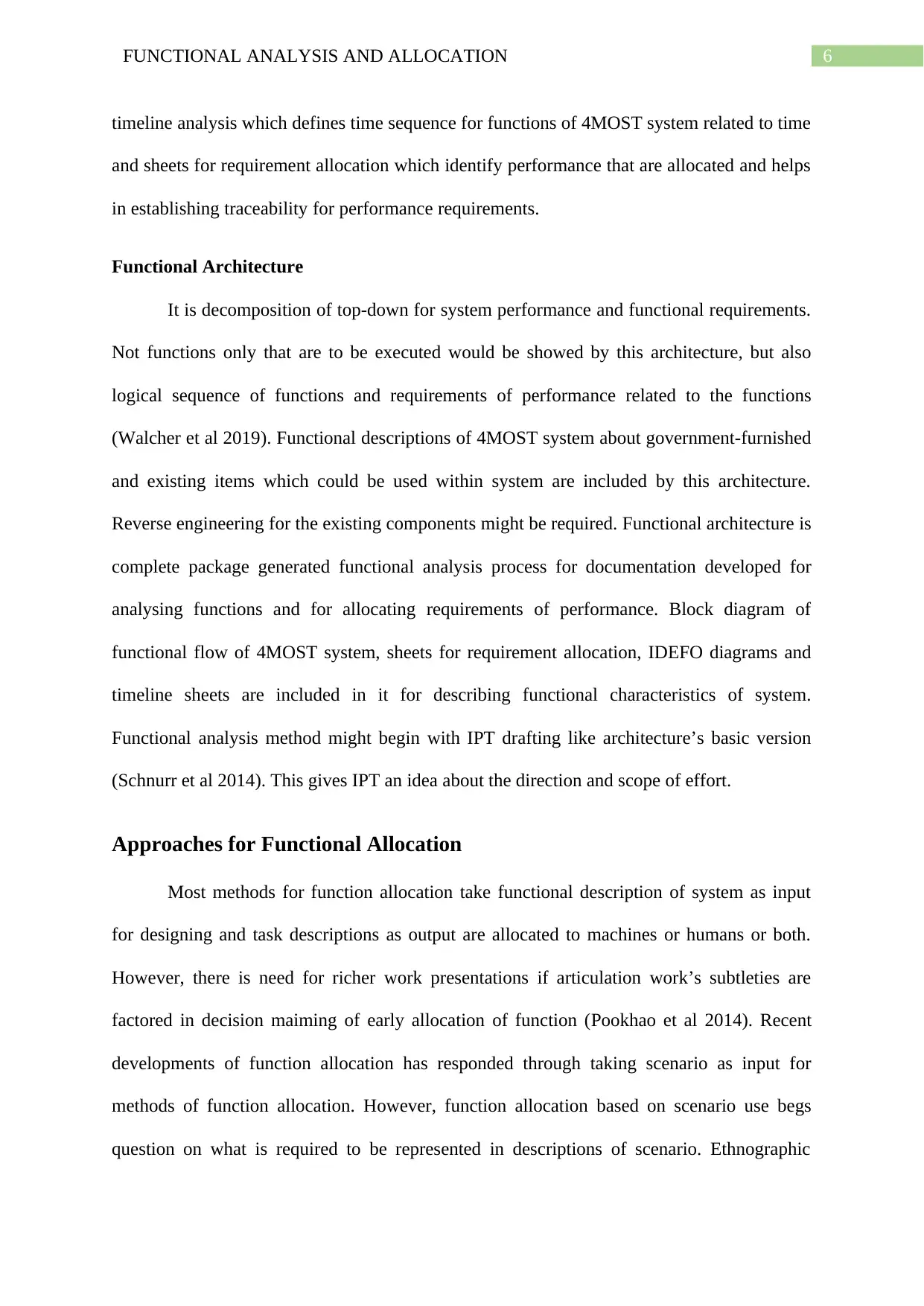
6FUNCTIONAL ANALYSIS AND ALLOCATION
timeline analysis which defines time sequence for functions of 4MOST system related to time
and sheets for requirement allocation which identify performance that are allocated and helps
in establishing traceability for performance requirements.
Functional Architecture
It is decomposition of top-down for system performance and functional requirements.
Not functions only that are to be executed would be showed by this architecture, but also
logical sequence of functions and requirements of performance related to the functions
(Walcher et al 2019). Functional descriptions of 4MOST system about government-furnished
and existing items which could be used within system are included by this architecture.
Reverse engineering for the existing components might be required. Functional architecture is
complete package generated functional analysis process for documentation developed for
analysing functions and for allocating requirements of performance. Block diagram of
functional flow of 4MOST system, sheets for requirement allocation, IDEFO diagrams and
timeline sheets are included in it for describing functional characteristics of system.
Functional analysis method might begin with IPT drafting like architecture’s basic version
(Schnurr et al 2014). This gives IPT an idea about the direction and scope of effort.
Approaches for Functional Allocation
Most methods for function allocation take functional description of system as input
for designing and task descriptions as output are allocated to machines or humans or both.
However, there is need for richer work presentations if articulation work’s subtleties are
factored in decision maiming of early allocation of function (Pookhao et al 2014). Recent
developments of function allocation has responded through taking scenario as input for
methods of function allocation. However, function allocation based on scenario use begs
question on what is required to be represented in descriptions of scenario. Ethnographic
timeline analysis which defines time sequence for functions of 4MOST system related to time
and sheets for requirement allocation which identify performance that are allocated and helps
in establishing traceability for performance requirements.
Functional Architecture
It is decomposition of top-down for system performance and functional requirements.
Not functions only that are to be executed would be showed by this architecture, but also
logical sequence of functions and requirements of performance related to the functions
(Walcher et al 2019). Functional descriptions of 4MOST system about government-furnished
and existing items which could be used within system are included by this architecture.
Reverse engineering for the existing components might be required. Functional architecture is
complete package generated functional analysis process for documentation developed for
analysing functions and for allocating requirements of performance. Block diagram of
functional flow of 4MOST system, sheets for requirement allocation, IDEFO diagrams and
timeline sheets are included in it for describing functional characteristics of system.
Functional analysis method might begin with IPT drafting like architecture’s basic version
(Schnurr et al 2014). This gives IPT an idea about the direction and scope of effort.
Approaches for Functional Allocation
Most methods for function allocation take functional description of system as input
for designing and task descriptions as output are allocated to machines or humans or both.
However, there is need for richer work presentations if articulation work’s subtleties are
factored in decision maiming of early allocation of function (Pookhao et al 2014). Recent
developments of function allocation has responded through taking scenario as input for
methods of function allocation. However, function allocation based on scenario use begs
question on what is required to be represented in descriptions of scenario. Ethnographic
Paraphrase This Document
Need a fresh take? Get an instant paraphrase of this document with our AI Paraphraser
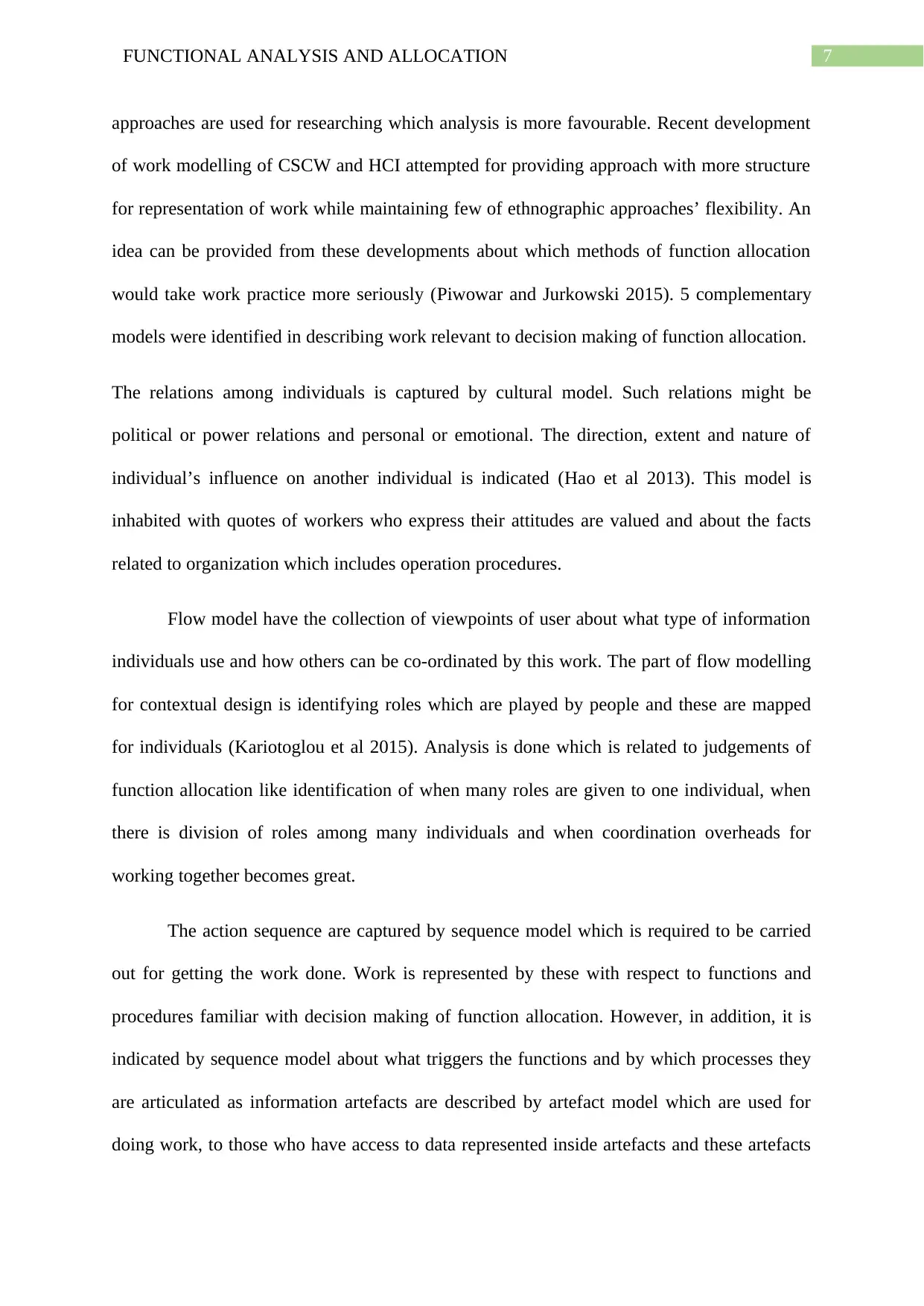
7FUNCTIONAL ANALYSIS AND ALLOCATION
approaches are used for researching which analysis is more favourable. Recent development
of work modelling of CSCW and HCI attempted for providing approach with more structure
for representation of work while maintaining few of ethnographic approaches’ flexibility. An
idea can be provided from these developments about which methods of function allocation
would take work practice more seriously (Piwowar and Jurkowski 2015). 5 complementary
models were identified in describing work relevant to decision making of function allocation.
The relations among individuals is captured by cultural model. Such relations might be
political or power relations and personal or emotional. The direction, extent and nature of
individual’s influence on another individual is indicated (Hao et al 2013). This model is
inhabited with quotes of workers who express their attitudes are valued and about the facts
related to organization which includes operation procedures.
Flow model have the collection of viewpoints of user about what type of information
individuals use and how others can be co-ordinated by this work. The part of flow modelling
for contextual design is identifying roles which are played by people and these are mapped
for individuals (Kariotoglou et al 2015). Analysis is done which is related to judgements of
function allocation like identification of when many roles are given to one individual, when
there is division of roles among many individuals and when coordination overheads for
working together becomes great.
The action sequence are captured by sequence model which is required to be carried
out for getting the work done. Work is represented by these with respect to functions and
procedures familiar with decision making of function allocation. However, in addition, it is
indicated by sequence model about what triggers the functions and by which processes they
are articulated as information artefacts are described by artefact model which are used for
doing work, to those who have access to data represented inside artefacts and these artefacts
approaches are used for researching which analysis is more favourable. Recent development
of work modelling of CSCW and HCI attempted for providing approach with more structure
for representation of work while maintaining few of ethnographic approaches’ flexibility. An
idea can be provided from these developments about which methods of function allocation
would take work practice more seriously (Piwowar and Jurkowski 2015). 5 complementary
models were identified in describing work relevant to decision making of function allocation.
The relations among individuals is captured by cultural model. Such relations might be
political or power relations and personal or emotional. The direction, extent and nature of
individual’s influence on another individual is indicated (Hao et al 2013). This model is
inhabited with quotes of workers who express their attitudes are valued and about the facts
related to organization which includes operation procedures.
Flow model have the collection of viewpoints of user about what type of information
individuals use and how others can be co-ordinated by this work. The part of flow modelling
for contextual design is identifying roles which are played by people and these are mapped
for individuals (Kariotoglou et al 2015). Analysis is done which is related to judgements of
function allocation like identification of when many roles are given to one individual, when
there is division of roles among many individuals and when coordination overheads for
working together becomes great.
The action sequence are captured by sequence model which is required to be carried
out for getting the work done. Work is represented by these with respect to functions and
procedures familiar with decision making of function allocation. However, in addition, it is
indicated by sequence model about what triggers the functions and by which processes they
are articulated as information artefacts are described by artefact model which are used for
doing work, to those who have access to data represented inside artefacts and these artefacts
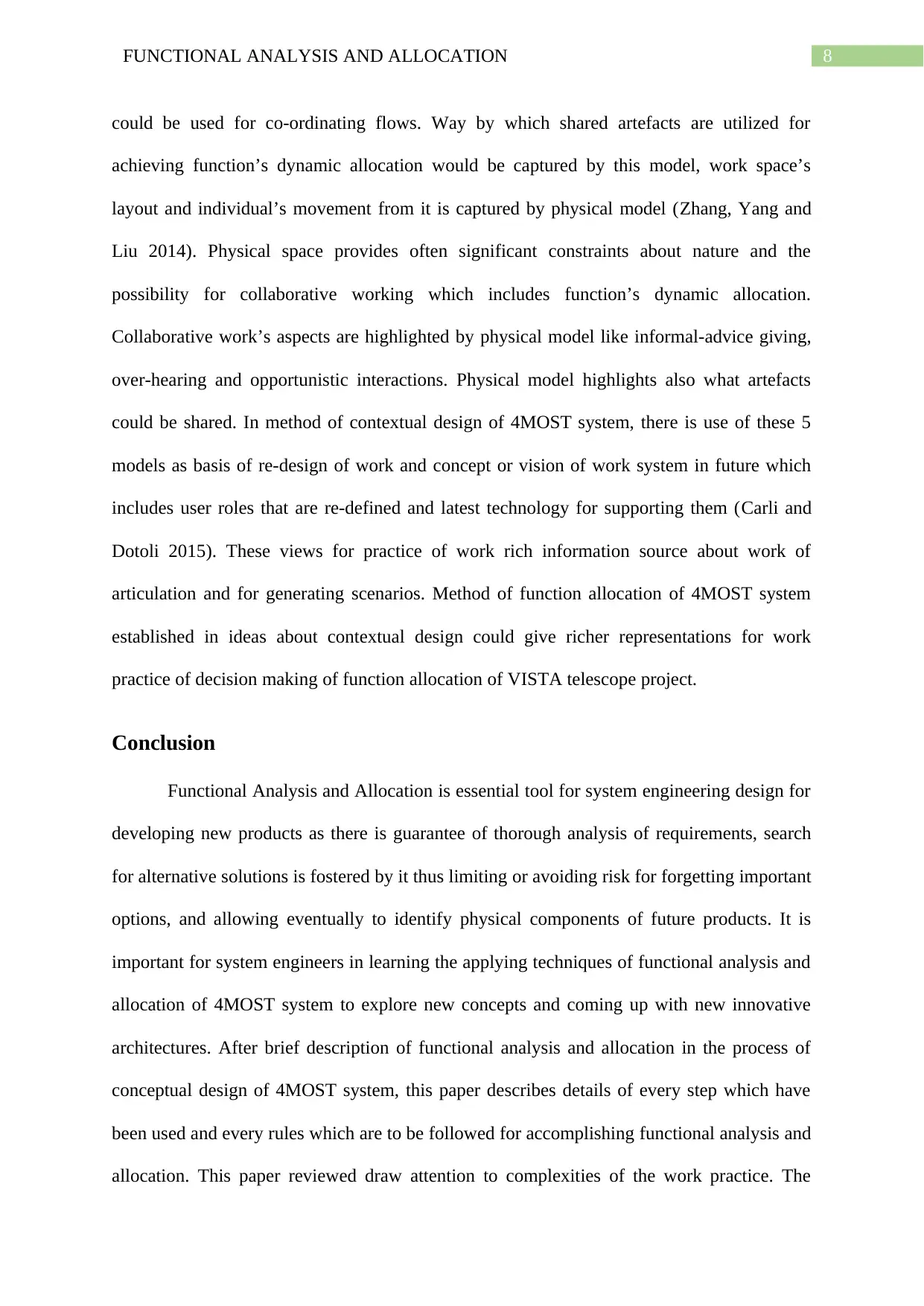
8FUNCTIONAL ANALYSIS AND ALLOCATION
could be used for co-ordinating flows. Way by which shared artefacts are utilized for
achieving function’s dynamic allocation would be captured by this model, work space’s
layout and individual’s movement from it is captured by physical model (Zhang, Yang and
Liu 2014). Physical space provides often significant constraints about nature and the
possibility for collaborative working which includes function’s dynamic allocation.
Collaborative work’s aspects are highlighted by physical model like informal-advice giving,
over-hearing and opportunistic interactions. Physical model highlights also what artefacts
could be shared. In method of contextual design of 4MOST system, there is use of these 5
models as basis of re-design of work and concept or vision of work system in future which
includes user roles that are re-defined and latest technology for supporting them (Carli and
Dotoli 2015). These views for practice of work rich information source about work of
articulation and for generating scenarios. Method of function allocation of 4MOST system
established in ideas about contextual design could give richer representations for work
practice of decision making of function allocation of VISTA telescope project.
Conclusion
Functional Analysis and Allocation is essential tool for system engineering design for
developing new products as there is guarantee of thorough analysis of requirements, search
for alternative solutions is fostered by it thus limiting or avoiding risk for forgetting important
options, and allowing eventually to identify physical components of future products. It is
important for system engineers in learning the applying techniques of functional analysis and
allocation of 4MOST system to explore new concepts and coming up with new innovative
architectures. After brief description of functional analysis and allocation in the process of
conceptual design of 4MOST system, this paper describes details of every step which have
been used and every rules which are to be followed for accomplishing functional analysis and
allocation. This paper reviewed draw attention to complexities of the work practice. The
could be used for co-ordinating flows. Way by which shared artefacts are utilized for
achieving function’s dynamic allocation would be captured by this model, work space’s
layout and individual’s movement from it is captured by physical model (Zhang, Yang and
Liu 2014). Physical space provides often significant constraints about nature and the
possibility for collaborative working which includes function’s dynamic allocation.
Collaborative work’s aspects are highlighted by physical model like informal-advice giving,
over-hearing and opportunistic interactions. Physical model highlights also what artefacts
could be shared. In method of contextual design of 4MOST system, there is use of these 5
models as basis of re-design of work and concept or vision of work system in future which
includes user roles that are re-defined and latest technology for supporting them (Carli and
Dotoli 2015). These views for practice of work rich information source about work of
articulation and for generating scenarios. Method of function allocation of 4MOST system
established in ideas about contextual design could give richer representations for work
practice of decision making of function allocation of VISTA telescope project.
Conclusion
Functional Analysis and Allocation is essential tool for system engineering design for
developing new products as there is guarantee of thorough analysis of requirements, search
for alternative solutions is fostered by it thus limiting or avoiding risk for forgetting important
options, and allowing eventually to identify physical components of future products. It is
important for system engineers in learning the applying techniques of functional analysis and
allocation of 4MOST system to explore new concepts and coming up with new innovative
architectures. After brief description of functional analysis and allocation in the process of
conceptual design of 4MOST system, this paper describes details of every step which have
been used and every rules which are to be followed for accomplishing functional analysis and
allocation. This paper reviewed draw attention to complexities of the work practice. The
⊘ This is a preview!⊘
Do you want full access?
Subscribe today to unlock all pages.

Trusted by 1+ million students worldwide

9FUNCTIONAL ANALYSIS AND ALLOCATION
contingent nature is often highlighted and the steps necessary for making work successful and
effective. Practitioner’s work is assumed to be design problem of system’s minimum
complex part. However studies of ethnography are criticised often for work complexities
without providing constructive solution as for designing better systems.
contingent nature is often highlighted and the steps necessary for making work successful and
effective. Practitioner’s work is assumed to be design problem of system’s minimum
complex part. However studies of ethnography are criticised often for work complexities
without providing constructive solution as for designing better systems.
Paraphrase This Document
Need a fresh take? Get an instant paraphrase of this document with our AI Paraphraser
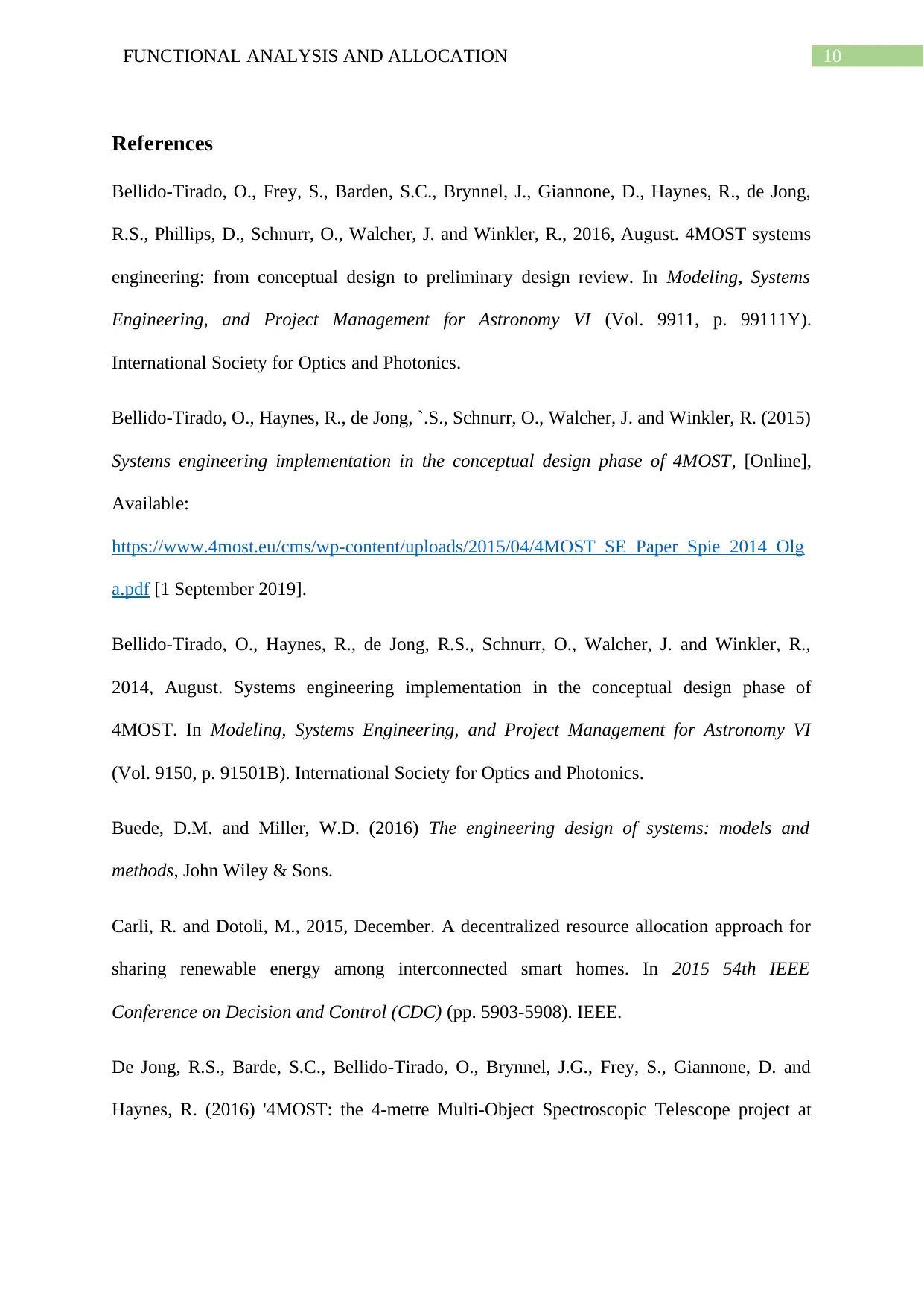
10FUNCTIONAL ANALYSIS AND ALLOCATION
References
Bellido-Tirado, O., Frey, S., Barden, S.C., Brynnel, J., Giannone, D., Haynes, R., de Jong,
R.S., Phillips, D., Schnurr, O., Walcher, J. and Winkler, R., 2016, August. 4MOST systems
engineering: from conceptual design to preliminary design review. In Modeling, Systems
Engineering, and Project Management for Astronomy VI (Vol. 9911, p. 99111Y).
International Society for Optics and Photonics.
Bellido-Tirado, O., Haynes, R., de Jong, `.S., Schnurr, O., Walcher, J. and Winkler, R. (2015)
Systems engineering implementation in the conceptual design phase of 4MOST, [Online],
Available:
https://www.4most.eu/cms/wp-content/uploads/2015/04/4MOST_SE_Paper_Spie_2014_Olg
a.pdf [1 September 2019].
Bellido-Tirado, O., Haynes, R., de Jong, R.S., Schnurr, O., Walcher, J. and Winkler, R.,
2014, August. Systems engineering implementation in the conceptual design phase of
4MOST. In Modeling, Systems Engineering, and Project Management for Astronomy VI
(Vol. 9150, p. 91501B). International Society for Optics and Photonics.
Buede, D.M. and Miller, W.D. (2016) The engineering design of systems: models and
methods, John Wiley & Sons.
Carli, R. and Dotoli, M., 2015, December. A decentralized resource allocation approach for
sharing renewable energy among interconnected smart homes. In 2015 54th IEEE
Conference on Decision and Control (CDC) (pp. 5903-5908). IEEE.
De Jong, R.S., Barde, S.C., Bellido-Tirado, O., Brynnel, J.G., Frey, S., Giannone, D. and
Haynes, R. (2016) '4MOST: the 4-metre Multi-Object Spectroscopic Telescope project at
References
Bellido-Tirado, O., Frey, S., Barden, S.C., Brynnel, J., Giannone, D., Haynes, R., de Jong,
R.S., Phillips, D., Schnurr, O., Walcher, J. and Winkler, R., 2016, August. 4MOST systems
engineering: from conceptual design to preliminary design review. In Modeling, Systems
Engineering, and Project Management for Astronomy VI (Vol. 9911, p. 99111Y).
International Society for Optics and Photonics.
Bellido-Tirado, O., Haynes, R., de Jong, `.S., Schnurr, O., Walcher, J. and Winkler, R. (2015)
Systems engineering implementation in the conceptual design phase of 4MOST, [Online],
Available:
https://www.4most.eu/cms/wp-content/uploads/2015/04/4MOST_SE_Paper_Spie_2014_Olg
a.pdf [1 September 2019].
Bellido-Tirado, O., Haynes, R., de Jong, R.S., Schnurr, O., Walcher, J. and Winkler, R.,
2014, August. Systems engineering implementation in the conceptual design phase of
4MOST. In Modeling, Systems Engineering, and Project Management for Astronomy VI
(Vol. 9150, p. 91501B). International Society for Optics and Photonics.
Buede, D.M. and Miller, W.D. (2016) The engineering design of systems: models and
methods, John Wiley & Sons.
Carli, R. and Dotoli, M., 2015, December. A decentralized resource allocation approach for
sharing renewable energy among interconnected smart homes. In 2015 54th IEEE
Conference on Decision and Control (CDC) (pp. 5903-5908). IEEE.
De Jong, R.S., Barde, S.C., Bellido-Tirado, O., Brynnel, J.G., Frey, S., Giannone, D. and
Haynes, R. (2016) '4MOST: the 4-metre Multi-Object Spectroscopic Telescope project at
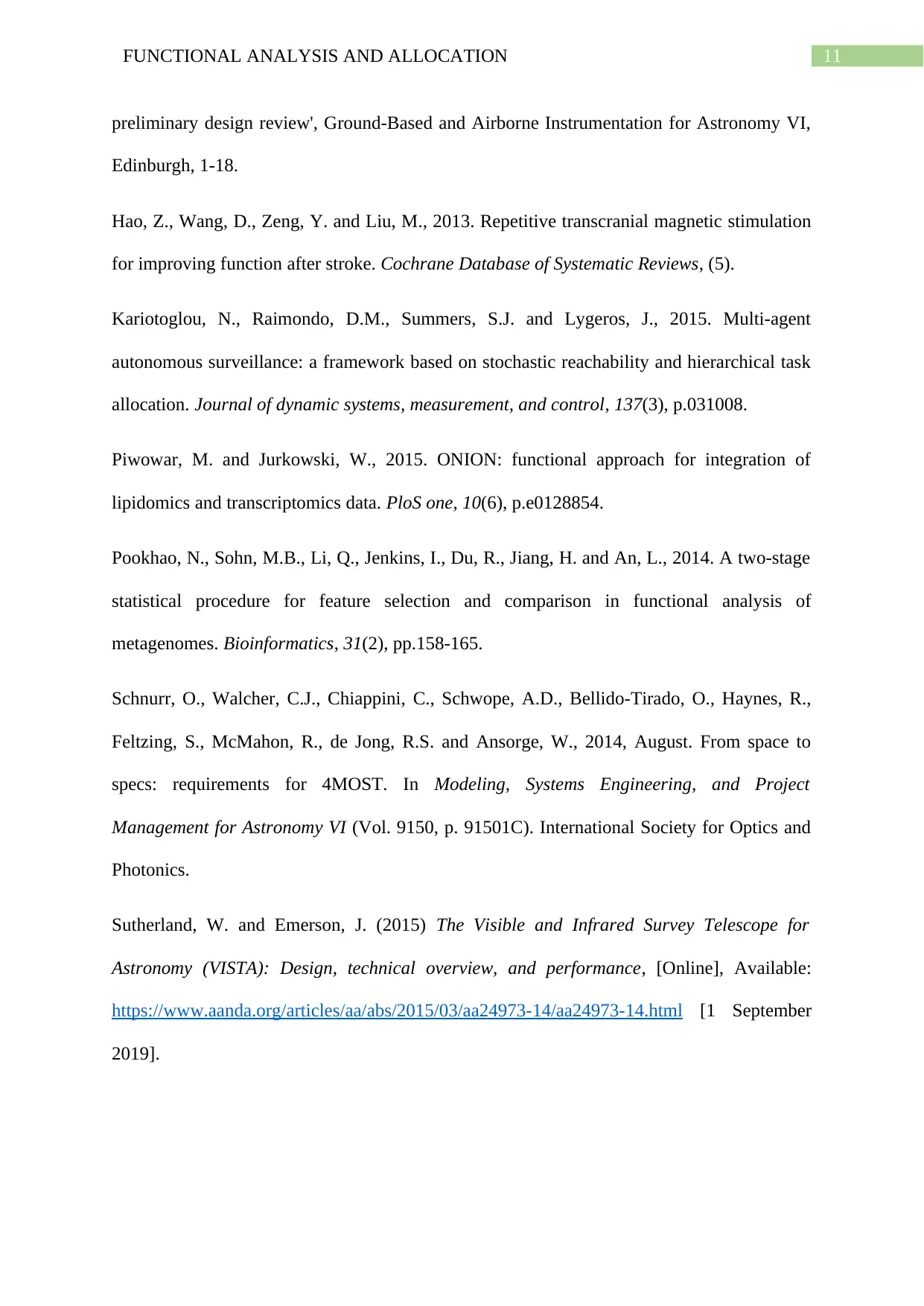
11FUNCTIONAL ANALYSIS AND ALLOCATION
preliminary design review', Ground-Based and Airborne Instrumentation for Astronomy VI,
Edinburgh, 1-18.
Hao, Z., Wang, D., Zeng, Y. and Liu, M., 2013. Repetitive transcranial magnetic stimulation
for improving function after stroke. Cochrane Database of Systematic Reviews, (5).
Kariotoglou, N., Raimondo, D.M., Summers, S.J. and Lygeros, J., 2015. Multi-agent
autonomous surveillance: a framework based on stochastic reachability and hierarchical task
allocation. Journal of dynamic systems, measurement, and control, 137(3), p.031008.
Piwowar, M. and Jurkowski, W., 2015. ONION: functional approach for integration of
lipidomics and transcriptomics data. PloS one, 10(6), p.e0128854.
Pookhao, N., Sohn, M.B., Li, Q., Jenkins, I., Du, R., Jiang, H. and An, L., 2014. A two-stage
statistical procedure for feature selection and comparison in functional analysis of
metagenomes. Bioinformatics, 31(2), pp.158-165.
Schnurr, O., Walcher, C.J., Chiappini, C., Schwope, A.D., Bellido-Tirado, O., Haynes, R.,
Feltzing, S., McMahon, R., de Jong, R.S. and Ansorge, W., 2014, August. From space to
specs: requirements for 4MOST. In Modeling, Systems Engineering, and Project
Management for Astronomy VI (Vol. 9150, p. 91501C). International Society for Optics and
Photonics.
Sutherland, W. and Emerson, J. (2015) The Visible and Infrared Survey Telescope for
Astronomy (VISTA): Design, technical overview, and performance, [Online], Available:
https://www.aanda.org/articles/aa/abs/2015/03/aa24973-14/aa24973-14.html [1 September
2019].
preliminary design review', Ground-Based and Airborne Instrumentation for Astronomy VI,
Edinburgh, 1-18.
Hao, Z., Wang, D., Zeng, Y. and Liu, M., 2013. Repetitive transcranial magnetic stimulation
for improving function after stroke. Cochrane Database of Systematic Reviews, (5).
Kariotoglou, N., Raimondo, D.M., Summers, S.J. and Lygeros, J., 2015. Multi-agent
autonomous surveillance: a framework based on stochastic reachability and hierarchical task
allocation. Journal of dynamic systems, measurement, and control, 137(3), p.031008.
Piwowar, M. and Jurkowski, W., 2015. ONION: functional approach for integration of
lipidomics and transcriptomics data. PloS one, 10(6), p.e0128854.
Pookhao, N., Sohn, M.B., Li, Q., Jenkins, I., Du, R., Jiang, H. and An, L., 2014. A two-stage
statistical procedure for feature selection and comparison in functional analysis of
metagenomes. Bioinformatics, 31(2), pp.158-165.
Schnurr, O., Walcher, C.J., Chiappini, C., Schwope, A.D., Bellido-Tirado, O., Haynes, R.,
Feltzing, S., McMahon, R., de Jong, R.S. and Ansorge, W., 2014, August. From space to
specs: requirements for 4MOST. In Modeling, Systems Engineering, and Project
Management for Astronomy VI (Vol. 9150, p. 91501C). International Society for Optics and
Photonics.
Sutherland, W. and Emerson, J. (2015) The Visible and Infrared Survey Telescope for
Astronomy (VISTA): Design, technical overview, and performance, [Online], Available:
https://www.aanda.org/articles/aa/abs/2015/03/aa24973-14/aa24973-14.html [1 September
2019].
⊘ This is a preview!⊘
Do you want full access?
Subscribe today to unlock all pages.

Trusted by 1+ million students worldwide
1 out of 15
Related Documents
Your All-in-One AI-Powered Toolkit for Academic Success.
+13062052269
info@desklib.com
Available 24*7 on WhatsApp / Email
![[object Object]](/_next/static/media/star-bottom.7253800d.svg)
Unlock your academic potential
Copyright © 2020–2025 A2Z Services. All Rights Reserved. Developed and managed by ZUCOL.




